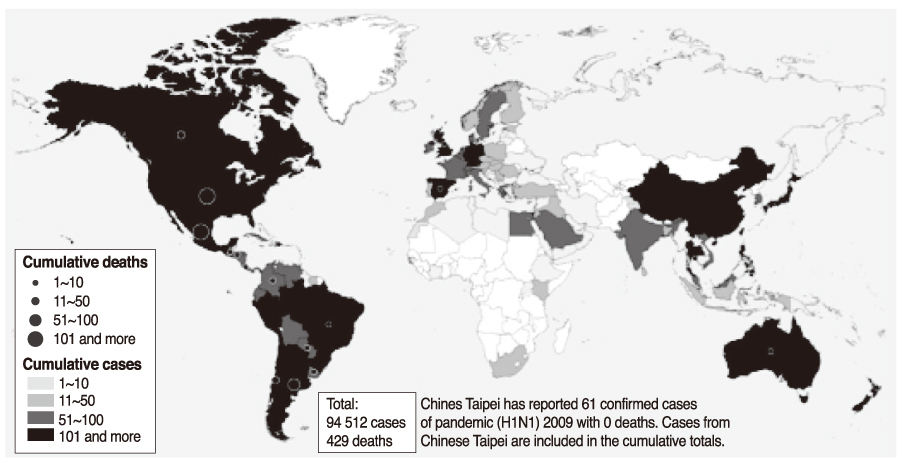 |
 |
- Search
| J Korean Med Assoc > Volume 52(8); 2009 > Article |
Abstract
In late April 2009, a swine-origin novel influenza A/H1N1 virus was identified among humans in Mexico and the United States. It was made known that novel H1N1 virus was antigenically and genetically unrelated to human seasonal influenza viruses and genetically related to swine influenza viruses. Since then, It has rapidly spread to every continent, and WHO promptly declared the virus as the the first influenza pandemic of 21st century on June 11, 2009. As of July 9, 2009 a total of 94,512 confirmed cases including 429 deaths were reported worldwide. Children and young adults were more commonly infected with novel influenza A/H1N1 virus with the a small percentage of elderly population. Most cases of influenza A/H1N1 infection were uncomplicated, characterized by influenza-like symptoms and spontaneous recovery. Some cases resulted in gastrointestinal symptoms including diarrhea and vomiting. About 3~9% of patients with confirmed cases have been hospitalized, and some of them have had previous medical conditions such as asthma, cardiovascular disease, diabetes, immunosuppressive therapy, pregnancy and morbid obesity. Case fatality rates vary from 1.2% to less than 0.1% while relatively higher in developing countries. This review describes the current epidemiology, clinical manifestations, treatment, infection control and prospects of the 2009 influenza A/H1N1 pandemic.
References
1. Garten RJ, Davis CT, Russell CA, Shu B, Lindstrom S, Balish A, Sessions WM, Xu X, Skepner E, Deyde V, Okomo-Adhiambo M, Gubareva L, Barnes J, Smith CB, Emery SL, Hillman MJ, Rivailler P, Smagala J, de Graaf M, Burke DF, Fouchier RA, Pappas C, Alpuche-Aranda CM, López-Gatell H, Olivera H, López I, Myers CA, Faix D, Blair PJ, Yu C, Keene KM, Dotson PD Jr, Boxrud D, Sambol AR, Abid SH, St George K, Bannerman T, Moore AL, Stringer DJ, Blevins P, Demmler-Harrison GJ, Ginsberg M, Kriner P, Waterman S, Smole S, Guevara HF, Belongia EA, Clark PA, Beatrice ST, Donis R, Katz J, Finelli L, Bridges CB, Shaw M, Jernigan DB, Uyeki TM, Smith DJ, Klimov AI, Cox NJ. Antigenic and genetic characteristics of swine-origin 2009 A (H1N1) influenza viruses circulating in humans. Science 2009;325:197-201.
2. World now at the start of 2009 influenza pandemic. WHO 2009;07. 11. (http://www.who.int/mediacentre/news/statements/2009/h1n1_pandemic_phase6_20090611/en/inde x.html)
3. Khan K, Arino J, Hu W, Raposo P, Sears J, Calderon F, Heidebrecht C, Macdonald M, Liauw J, Chan A, Gardam M. Spread of a novel influenza A (H1N1) virus via global airline transportation. N Engl J Med 2009;361:212-214.
4. Pandemic (H1N1) 2009- update 58. WHO 2009;07. 06. (http://www.who.int/csr/don/2009_07_06/en/index.html)
5. Changes in reporting requirements for pandemic (H1N1) 2009 virus infection. WHO 2009;07. 16. (http://www.who.int/csr/disease/swineflu/notes/h1n1_surveillance_200907 10/en/index.html)
6. Current status of novel influenza A (H1N1). KCDC 2009;(http://www.cdc.go.kr/kcdchome/jsp/home/main/default.jsp)
7. WHO . New influenza A (H1N1) virus: global epidemiological situation, 19 June 2009. Weekly Epidemiological Record 2009;84:249-256.
8. Novel Swine-Origin Influenza A (H1N1) Virus Investigation Team. Emergence of a novel swine-origin influenza A (H1N1) virus in humans. N Engl J Med 2009;360:2605-2615.
9. CDC. Serum cross-reactive antibody response to a novel influenza A (H1N1) virus after vaccination with seasonal influenza vaccine. MMWR 2009;58:521-524.
10. Fraser C, Donnelly CA, Cauchemez S, Hanage WP, Van Kerkhove MD, Hollingsworth TD, Griffin J, Baggaley RF, Jenkins HE, Lyons EJ, Jombart T, Hinsley WR, Grassly NC, Balloux F, Ghani AC, Ferguson NM, Rambaut A, Pybus OG, Lopez-Gatell H, Alpuche-Aranda CM, Chapela IB, Zavala EP, Guevara DM, Checchi F, Garcia E, Hugonnet S, Roth C. WHO Rapid Pandemic Assessment Collaboration. Pandemic potential of a novel strain of influenza A (H1N1): early findings. Science 2009;324:1557-1561.
11. Itoh Y, Shinya K, Kiso M, Watanabe T, Sakoda Y, Hatta M, Muramoto Y, Tamura D, Sakai-Tagawa Y, Noda T, Sakabe S, Imai M, Hatta Y, Watanabe S, Li C, Yamada S, Fujii K, Murakami S, Imai H, Kakugawa S, Ito M, Takano R, Iwatsuki-Horimoto K, Shimojima M, Horimoto T, Goto H, Takahashi K, Makino A, Ishigaki H, Nakayama M, Okamatsu M, Takahashi K, Warshauer D, Shult PA, Saito R, Suzuki H, Furuta Y, Yamashita M, Mitamura K, Nakano K, Nakamura M, Brockman-Schneider R, Hiroshi Mitamura H, Yamazaki M, Sugaya N, Suresh M, Ozawa M, Neumann G, Gern J, Kida H, Ogasawara K, Kawaoka Y. In vitro and in vivo characterization of new swine-origin H1N1 influenza viruses. Nature 2009;(published online Jul 13).
12. Garske T, Legrand J, Donnelly CA, Ward H, Cauchemez S, Fraser C, Ferguson NM, Ghani AC. Assessing the severity of the novel influenza A/H1N1 pandemic. BMJ 2009;339:b2840.
13. Press release #42-09: community transmission of H1N1 flu appears to decline in New York City. New York City Department of Health and Mental Hygiene 2009;accessed June 2009. (http://www.nyc.gov/html/doh/html/pr2009/pr042-09.shtml)
14. Influenza A (H1N1)-update 42. WHO 2009;06. 03. (http://www.who.int/csr/don/2009_06_01a/en/index.html)
15. CDC. Interim guidance for screening for swine-origin influenza A (H1N1) by state and local health departments, hospitals, and clinicians in regions with few or no reported cases of swine influenza A (H1N1) 2009.
16. CDC. Interim guidance on specimen collection, processing, and testing for patients with suspected swine-origin influenza A (H1N1) virus infection 2009.
17. Ginochio CC, Zhang F, Manji R, Arora S, Bornfreund M, Falk L, Lotlikar M, Kowerska M, Becker G, Korologos D, de Geronimo M, Crawford JM. Evaluation of multiple test methods for the detection of the novel 2009 influenza A (H1N1) during the New York City outbreak. J Clin Virol 2009;45:191-195.
18. CDC. Interim guidance on antiviral recommendations for patients with confirmed or suspected swine influenza A (H1N1) virus infection and close contacts 2009.
19. CDC. Interim guidance-pregnant women and swine influenza: considerations for clinicians 2009.
- TOOLS
-
METRICS

-
Related articles in
J Korean Med Assoc -
Possibility of Novel Influenza Pandemic and Preparedness Plan2005 September;48(9)
Epidemiology of HIV/AIDS: Current Status, Trend and Prospect2007 April;50(4)
Research on Uterine Cervical Cancer in Korea: Current Status and Perspectives2007 September;50(9)
Stem cells and clinical trials: the current status and future perspectives2011 May;54(5)







